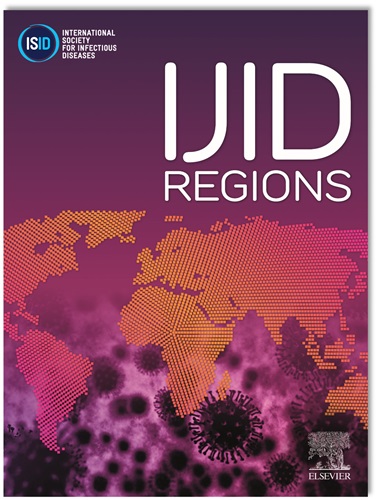Adverse events associated with COVID-19 vaccination or diagnosis among pregnant and non-pregnant women in the United States, 2021-2022
IF 4.3
2区 医学
Q1 INFECTIOUS DISEASES
引用次数: 0
Abstract
Objectives
To quantify the incidence of adverse events after COVID-19 vaccination and COVID-19 diagnosis in women of reproductive age; to examine pregnancy as a potential risk modifier.
Methods
An exposure-matched cohort study of >1 million women, 11 December 2020–30 September 2022, United States. COVID-19 vaccination, COVID-19 diagnoses, and medically-attended adverse events – including immunologic, neurologic, cerebrovascular, thromboembolic, cardiovascular, respiratory, thrombocytopenic, and coagulative events – were identified from inpatient and outpatient medical claims. Exposed participants were matched with up to four unexposed participants on pregnancy and propensity for COVID-19 vaccination (or diagnosis). Odds ratios quantifying the associations between exposures and adverse events were estimated using logistic regression models, with pregnancy incorporated as an effect modifier.
Results
We identified 3556 (120.6 per 10,000) adverse events among pregnant women, with near-identical incidence rates between those unvaccinated and vaccinated against COVID-19 (120.5 and 120.7 per 10,000; adjusted odds ratio [aOR]=1.04 [95% CI: 0.96, 1.13]). The incidence of adverse events was lower among non-pregnant women (n = 3581; 95.5 per 10,000); however, vaccination effects were stronger (90.2 and 101.6 per 10,000 among unvaccinated and vaccinated women, respectively; aOR = 1.19, 95% CI: 1.11, 1.28). More adverse events occurred following COVID-19 diagnosis, including pericarditis (pregnant: aOR = 5.35, 95% CI: 2.24, 12.79; non-pregnant: aOR = 5.57, 95% CI: 3.02, 10.27) and acute myocardial infarction (pregnant: aOR = 3.15, 95% CI: 1.56, 6.37; non-pregnant: aOR = 4.34, 95% CI: 2.79, 6.76).
Conclusion
Adverse events associated with COVID-19 vaccination were rare in women, but substantially elevated following COVID-19 diagnosis. Being pregnant did not increase adverse event risk, reinforcing the safety of COVID-19 vaccination during pregnancy.
2021-2022年美国孕妇和非孕妇中与COVID-19疫苗接种或诊断相关的不良事件
目的:量化育龄妇女接种COVID-19疫苗和诊断COVID-19不良事件的发生率;将怀孕作为潜在的风险调节因素进行检查。方法:在2020年12月11日至2022年9月30日期间,在美国进行了一项暴露匹配队列研究。从住院和门诊医疗索赔中确定了COVID-19疫苗接种、COVID-19诊断和医疗相关不良事件,包括免疫、神经、脑血管、血栓栓塞、心血管、呼吸、血小板减少和凝血事件。暴露的参与者与多达四名未暴露的参与者在怀孕和COVID-19疫苗接种(或诊断)倾向方面进行匹配。使用逻辑回归模型估计暴露与不良事件之间的非因果关联的比值比,并将妊娠纳入影响调节因子。结果:我们在孕妇中发现了3,556例(120.6 / 10,000)不良事件,未接种疫苗和接种了COVID-19疫苗的孕妇的发病率几乎相同(120.5 / 10,000和120.7 / 10,000;校正优势比[aOR]=1.04 [95%CI 0.96,1.13])。非孕妇的不良事件发生率较低(n=3,581; 95.5 / 10,000);然而,接种疫苗的效果更强(90.2和101.6 / 10000;aOR=1.19, 95%CI 1.11,1.28)。新冠肺炎确诊后,心包炎(孕妇:aOR=5.35, 95%CI 2.24,12.79;非孕妇:aOR=5.57, 95%CI 3.02,10.27)和急性心肌梗死(孕妇:aOR=3.15, 95%CI 1.56,6.37;非孕妇:aOR=4.34, 95%CI 2.79,6.76)的不良事件发生率更高。结论:与COVID-19疫苗接种相关的不良事件在女性中罕见,但在COVID-19诊断后显著增加。妊娠期未增加不良事件风险,强化了妊娠期接种COVID-19疫苗的安全性。
本文章由计算机程序翻译,如有差异,请以英文原文为准。
求助全文
约1分钟内获得全文
求助全文
来源期刊
CiteScore
18.90
自引率
2.40%
发文量
1020
审稿时长
30 days
期刊介绍:
International Journal of Infectious Diseases (IJID)
Publisher: International Society for Infectious Diseases
Publication Frequency: Monthly
Type: Peer-reviewed, Open Access
Scope:
Publishes original clinical and laboratory-based research.
Reports clinical trials, reviews, and some case reports.
Focuses on epidemiology, clinical diagnosis, treatment, and control of infectious diseases.
Emphasizes diseases common in under-resourced countries.

 求助内容:
求助内容: 应助结果提醒方式:
应助结果提醒方式:


